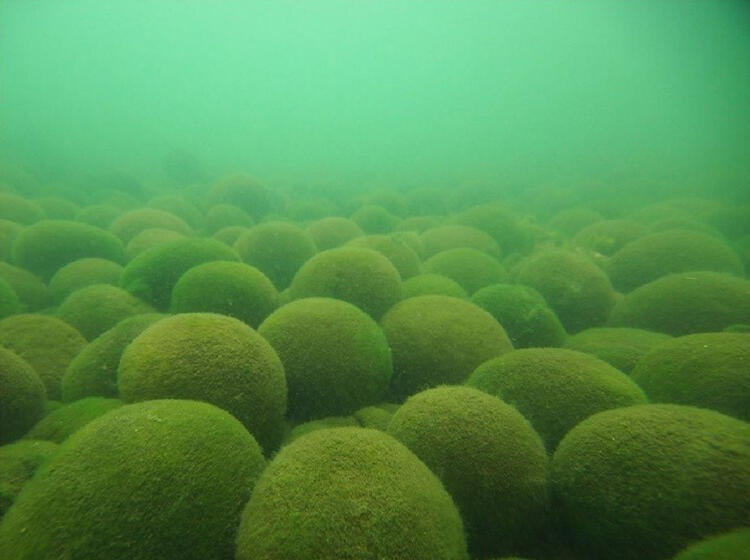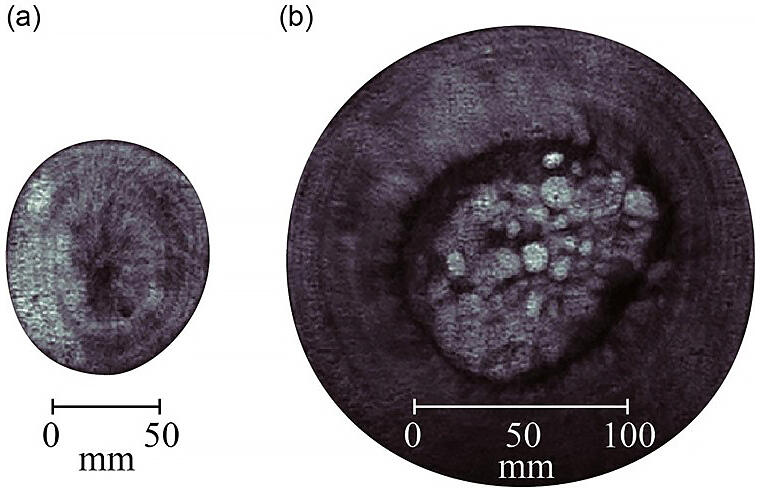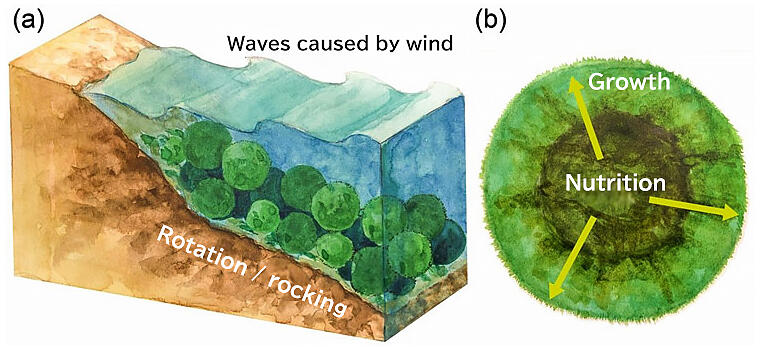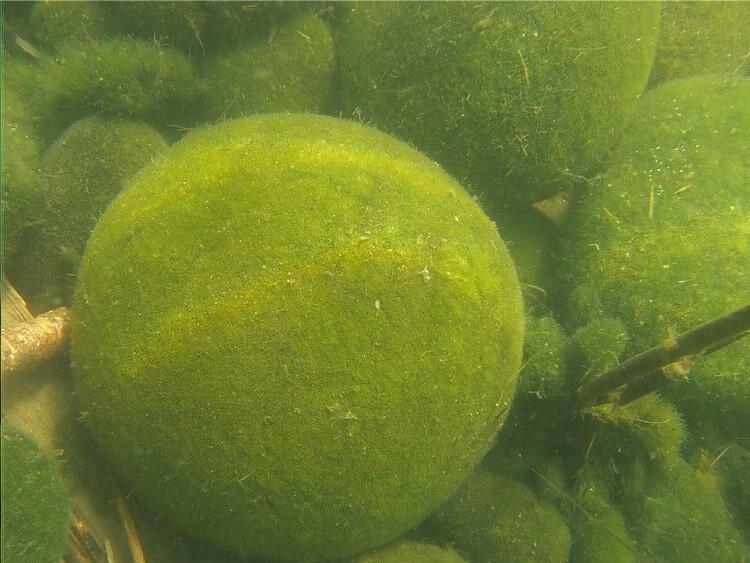Marimo is typically round and green with an attractive appearance. Despite its well-known name and appearance, it is said that the only mature individuals living in the world today are found in Lake Akan in Kushiro City, Hokkaido. The Ministry of the Environment designated it an endangered species. Research groups such as that at Kobe University and the Kushiro City Board of Education announced that they have discovered that the internal structure of such marimo have a striped pattern that closely resembles annual rings of trees, through which their age can be estimated. They explored the internal structure by customizing and utilizing medical inspection equipment. It is expected that the results will be useful for conservation by understanding the speed and mechanism of marimo growth.

Examinations using the famous MRI just like in hospitals
Marimo is a green alga that grows spherically by photosynthesis while rotating under the influence of waves on the water surface, with innumerable entwined filamentous algae ("filamentous bodies") with a length of several centimeters. It is distributed in lakes at high latitudes in the Northern Hemisphere, but today, only Lake Akan is home to those which grow in clusters with a diameter of 10 cm and more. Until recently, Iceland's Lake Mývatn was also known, but it is said that it almost disappeared in 2013 due to eutrophication.
Even at Lake Akan, due to deforestation and development from the first half of the 20th century, there has been an inflow of earth and sand, deterioration of the lake surface, eutrophication, and other issues, and the colonies that used to be in four places have been reduced to two sites. However, the speed of growth and the mechanism of nutrition supply, which are important for conservation activities, are not well understood. Since mature marimo is valuable, it is desirable to examine their internal structure in a non-destructive manner without cutting. Therefore, the research group modified and utilized medical MRI (magnetic resonance imaging) to investigate the internal structure.
They found a striped pattern of 4 to 5 cm resembling the rings of trees on the interior surface of marimo. It is thought that from spring to autumn when the ice on the surface of the lake is melting, marimo grows by rocking and rotating due to the influence of waves on the surface of the lake, thereby getting rid of organic substances inhibiting photosynthesis from the surface; from this the surface is smoothened, and the structure becomes spherical. On the other hand, when the lake surface freezes in winter, marimo hardly moves and its surface becomes rough. Taking this into consideration, the research group concluded that the striped pattern represents annual rings that indicate yearly growth, similar to that seen in trees.
In previous studies that used cutting for examination, opinions were divided over the presence or absence of annual rings. However, they were confirmed clearly using MRI. The width of one annual ring is 4.5 to 6.3 mm. The diameter grows by approximately 9 to 12.6 mm per year, so it takes 20 to 28 years to grow from a state of approximately 5 cm to a giant marimo of 30 cm. Opinions were divided regarding the speed of growth, but the researchers succeeded in narrowing it down.
It is also known that the inside of the grown marimo is hollow and does not contain algae because light does not reach this part and photosynthesis is not possible. As observed by MRI, the structure inside the annual rings is hollow.

Minimal nutritional circulation
The research group also tried to unravel the mysterious mechanism of the marimo's nutrient supply by diving, collecting water from inside using a syringe, and comparing the components with the surrounding lake water. The water inside contained nitrogen and phosphorus, which are essential for the growth of algae, at a higher concentration than the lake water. In contrast, there was less oxygen inside.
Inside the marimo, algae are peeled off and decomposed into nitrogen and phosphorus by bacteria. Oxygen may be low due to respiration by these bacteria. It was also found that while the marimo rotated and rocked, the water containing nitrogen and phosphorus slowly escaped to the outside. The water inside the marimo was replaced with the water outside over approximately 105 hours. It seems that the marimo grows by photosynthesis while reusing the nutrients it releases. MRI scans showed a white mass in the internal cavity that appeared to be in a stage of decomposition.
It is said that the area around the marimo colony of Lake Akan is not very nutritious, and there are many aquatic plants that require large amounts of nutrients. Dr. Yoichi Oyama (limnology), Curator of the Marimo Research Center, Kushiro City Board of Education, said, "In such an environment, it is unlikely that marimo would not take advantage of the large amounts of nutrients that it releases. The mechanism by which marimo grows has finally come to light.

The research group consists of researchers from Kobe University, Kushiro City Board of Education, Kitami Institute of Technology, Nishimuragumi (Hokkaido), and Housui Engineering Consultants Co. (Hokkaido). The results were published in the English journal Scientific Reports on November 10 and were announced by Kobe University on December 2nd.
Potential to be an important clue for conservation
Marimo shows a delicate balance between its spherical shape and nutrient circulation, but it has been pointed out that it may be lost due to climate change. Oyama stated, "It is a great achievement to know the growth rate, which is very important for conservation, and to obtain definitive evidence of the internal structure."
Keisuke Nakayama (Water Environmental Engineering), a professor at the Department of Civil Engineering, Graduate School of Engineering, Kobe University, said, "It is being clarified how marimo grows under the influence of the environment. It feels like we have finally set the stage for research into the protection and management of marimo. We would like to promote interdisciplinary research by linking specialized fields."
The beautiful green sphere that lives quietly on the bottom of the lake without saying anything appears like a symbol of nature conservation. There are high expectations for steady work to further clarify their ecology and aid in conservation so that they do not become the "tragic marimo" like in the famous Japanese Showa era song "Marimo-no-uta."

(KUSAKA Takeo / Science Portal Editorial Office)
Original article was provided by the Science Portal and has been translated by Science Japan.




